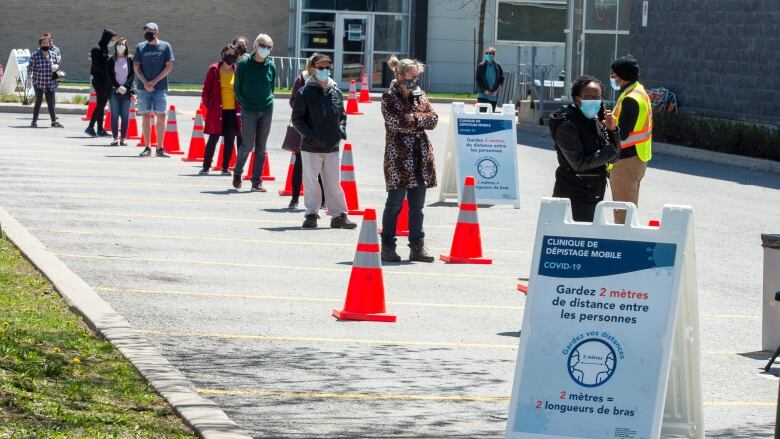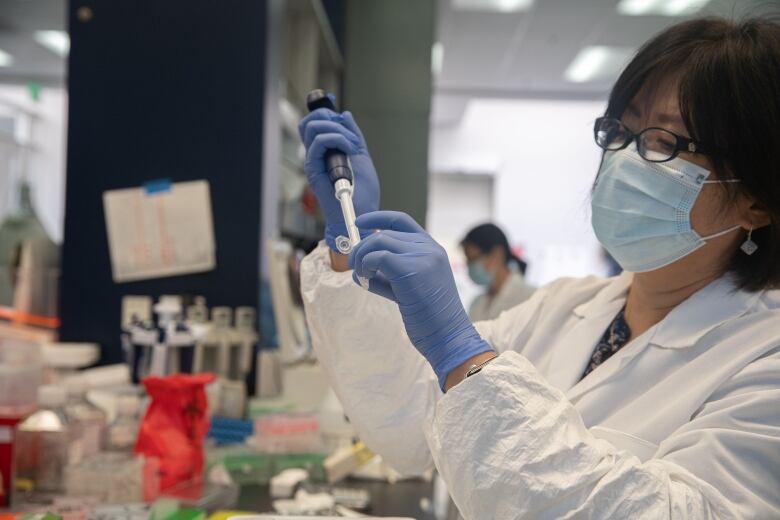How to interpret Rt, a number to measure the pandemic in Quebec
'Retrospective' tool shows how many other people a person with COVID-19 is likely to infect

Quebec's public health institute has begun publishing a key COVID-19 indicator known as Rt, which tracks the number of other people a single infected person is likely to infect.
Called the effective reproduction number, Rt is a measure of how fast the disease is spreading. A value higher than one means infections are increasing; lower than one means they're decreasing.
The Rt for Aug. 23 is 1.27, which means 100 people with the virus would infect another 127 people.
The rising Rt curve in August can be attributed in part to an outbreak connected to a karaoke night at a Quebec City bar, "but also other events," said Dr. Mathieu Maheu-Giroux, an assistant professor in the department of epidemiology and occupational health at McGill University who works with the health institute, the INSPQ.
During a technical briefing for journalists Thursday, Maheu-Giroux cautioned that Rt has shortcomings, and needs to be considered in concert with other measurements, but it nonetheless provides another way to understand the status of the pandemic.
It's a "descriptive tool" and "retrospective," said Maheu-Giroux. "It's not a tool to see what's going to occur in the future."
The INSPQ's Rt values have a 10-day lag because they depend not on the date of a reported positive test results but the likely date a person was infected.
The numbers will be updated weekly, Maheu-Giroux said, because day-to-day trends aren't as meaningful as trends established over longer periods of time.
"If I was a member of the public, I would like to see that number as close to one as possible and ideally below one, Maheu-Giroux said. "But it's only one indicator."
An Rt above one is not ideal, he said, but if all other indicators are OK such as thenumber of people in hospital then there is nothing to worry about. However,he added, "it needs to go down within a certain period of time."
Context is important
Rtalso has to be understood in context, Maheu-Giroux said. He cited the example of two provinces, one with 1,000 new cases each day and an Rt of one, and the other where new cases climb from 5 to 10, for an Rt of two.
A higher Rt is a concern, but "from a public health point of view, a situation with 1,000 new cases per day" may be more of a problem, he said.
Likewise, Rt doesn't take into account the specifics of outbreaks. Any situation where there is a steep rise in cases will cause the Rt value to increase, whether that rise is caused by a single outbreak or new cases scattered around the province, the latter being a bigger public health problem.

"It's much more concerning to have a place with 25 cases with unknown origin than to have 25 cases from a single outbreak," Maheu-Giroux said.
The number also has a slightly paradoxical feature: Maheu-Giroux said the main source of uncertainty in the calculations represented in the graph by the confidence bands around the plotted line is the number of cases. The higher the cases, the lower the uncertainty about Rt.
"If we have very few cases, you cannot base any decisions on that number."
This is also why Rt is given at a provincial level, rather than for individual regions, where case numbers are often verylow.
"The most robust portrait of the situation is the one of the province," Maheu-Giroux said.
Even that portrait is not robust enough for some experts. Mark Goldberg, an environmental epidemiologist and professor in the department of medicine at McGill University, expressed doubt in the accuracy of the provincial data behind the Rt value.
In an email, Goldberg said asymptomatic carriers, who may never get tested, could throw case numbers off significantly.
"Asymptomatics may be driving the pandemic," he wrote. "As well, Quebec is not doing a great job testing, nor in contact tracing, and this will affect estimates."












_(720p).jpg)


 OFFICIAL HD MUSIC VIDEO.jpg)
.jpg)



























































































